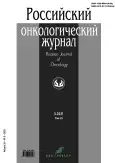Traditional and liquid-based cytology in the diagnosis of non-tumor lesions and endometrial tumors
- Authors: Karpova A.1, Shabalova I.P.1, Sozaeva L.G.1
-
Affiliations:
- Russian Medical Academy of Continuous Professional Education
- Issue: Vol 26, No 3 (2021)
- Pages: 85-92
- Section: Original Study Articles
- Submitted: 03.08.2022
- Accepted: 22.08.2022
- Published: 15.06.2021
- URL: https://rjonco.com/1028-9984/article/view/109593
- DOI: https://doi.org/10.17816/onco109593
- ID: 109593
Cite item
Abstract
BACKGROUND: Morphological examination of materials obtained during endometrial aspiration biopsy or diagnostic curettage is an integral part in the diagnosis of endometrial pathologies; however, these manipulations are invasive and have additional surgical and anesthetic risks. Therefore, the improvement of endometrial cytological examination is of great interest to minimize associated risks with high diagnostic potential. Currently, traditional cytology (TC) and liquid-based cytology (LBC) are employed for the morphological diagnosis of diseases of various localizations, but the possibilities of their combined use are insufficiently explored.
AIMS: To improve the cytological diagnosis of endometrial tumors and non-tumor lesions.
MATERIALS AND METHODS: The study enrolled 101 patients aged 22–79 years with endometrial pathologies and indications for surgical treatment and routine histological examination of operative specimen. Endometrial surface scrapings obtained during hysteroscopy (n=73) and postoperative specimen (n=28) were used for cytological examination. A portion of the obtained specimen was immediately applied to a TC slide, and the rest was placed in a vial with preserving medium for LBC. Statistical processing of the results was performed according to conventional methods using StatTech v. 2.8.8 (Stattech LLC, Russia).
RESULTS: Uninformative data were obtained in 9.9% of the cases in the TC and in 14.9% of cases in LC of uterine cavity specimens. The combined use of TC and LC reduced the number of observations with inadequate specimen to 6.9%. The presence of atypia in the cytological specimen (threshold value of atypical hyperplasia) correlated with the results of the histological examination (p<0.001).
CONCLUSIONS: The combined use of TC and LC allows increasing the number of observations with adequate specimens, improving the accessible and minimally invasive diagnosis of proliferative conditions and tumors.
Full Text
About the authors
Asel Karpova
Russian Medical Academy of Continuous Professional Education
Author for correspondence.
Email: aselique@gmail.com
ORCID iD: 0000-0003-3415-8183
SPIN-code: 7732-7663
Russian Federation, Moscow
Irina P. Shabalova
Russian Medical Academy of Continuous Professional Education
Email: irenshab@inbox.ru
ORCID iD: 0000-0002-7838-6279
SPIN-code: 7390-0085
MD, Dr. Sci. (Med.), Professor
Russian Federation, MoscowLarisa G. Sozaeva
Russian Medical Academy of Continuous Professional Education
Email: sozaewa@mail.ru
ORCID iD: 0000-0002-1793-5684
SPIN-code: 5452-8168
MD, Cand. Sci. (Med.), Assistant professor
Russian Federation, MoscowReferences
- Sung H, Ferlay J, Siegel RL, et al. Global Cancer Statistics 2020: GLOBOCAN Estimates of Incidence and Mortality Worldwide for 36 Cancers in 185 Countries. CA Cancer J Clin. 2021;71(3):209–249. doi: 10.3322/caac.21660
- Kaprin AD, Starinskii VV, Shahzadova AO, editors. Sostoyanie onkologicheskoi pomoshchi naseleniyu Rossii v 2020 godu. Мoscow: MNIOI im. P.A. Gertsena − filial FGBU «NMITs radiologii» Minzdrava Rossii, 2021. (In Russ). https://oncology-association.ru/wp-content/uploads/2021/10/pomoshh-2020-el.-versiya.pdf
- Haimovich S, Tanvir T. A Mini-Review of Office Hysteroscopic Techniques for Endometrial Tissue Sampling in Postmenopausal Bleeding. J Midlife Health. 2021;12(1):21–29. doi: 10.4103/jmh.jmh_42_21
- Protasova AE, Sobivchak MS, Bayramova NN, et al. Endometrial cancer: modern concepts of screening. Kazan medical journal. 2019;100(4):662–672. (In Russ). doi: 10.17816/KMJ2019-662
- Wang Q, Wang Q, Zhao L, et al. Endometrial Cytology as a Method to Improve the Accuracy of Diagnosis of Endometrial Cancer: Case Report and Meta-Analysis. Front Oncol. 2019;9:256. doi: 10.3389/fonc.2019.00256
- Lv S, Wang Q, Li Y, et al. A Clinical Comparative Study of Two Different Endometrial Cell Samplers for Evaluation of Endometrial Lesions by Cytopathological Diagnosis. Cancer Manag Res. 2020. N 12. P. 10551–10557. doi: 10.2147/CMAR.S272755
- Tabakman YuYu, Ivanov AE, Tarakanova OV. Vozmozhnosti tsitologicheskogo issledovaniya dlya diagnostiki raka endometriya. Moskovskaya meditsina. 2019;34(6):95–96. (In Russ).
- Shabalova IP. Klinicheskaya tsitologiya v 21 veke – tupik ili razvitie spetsial’nosti? Laboratoriya. 2015;(4):4–9. (In Russ).
Supplementary files











